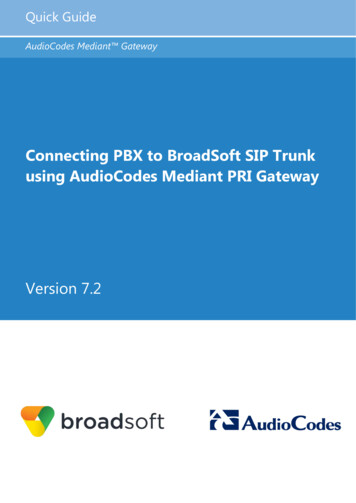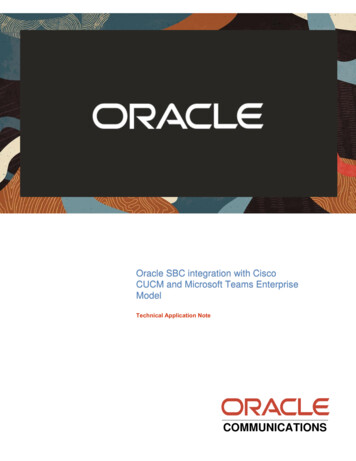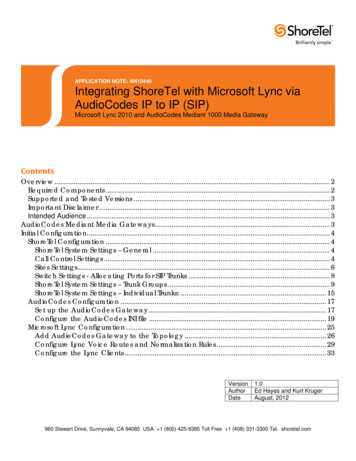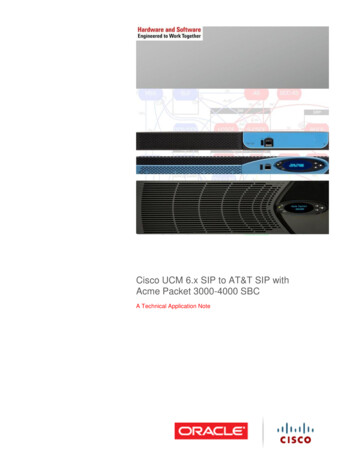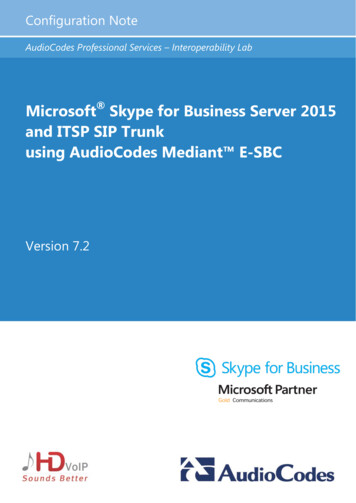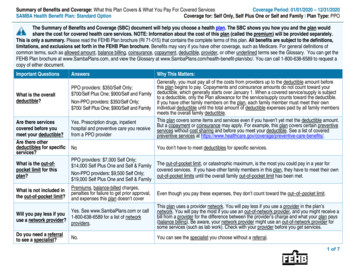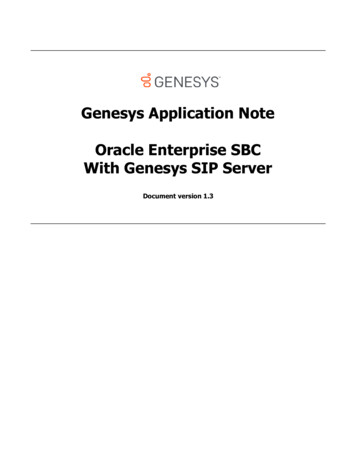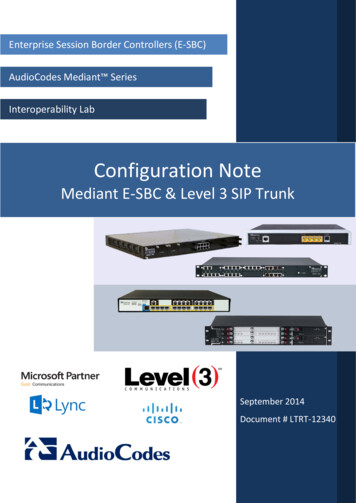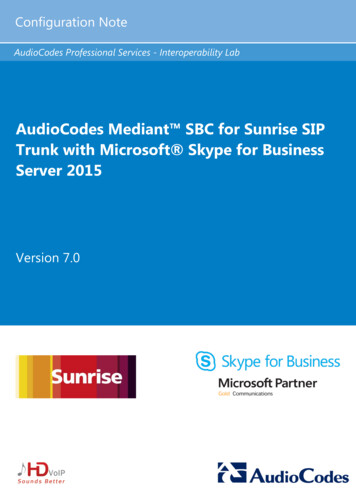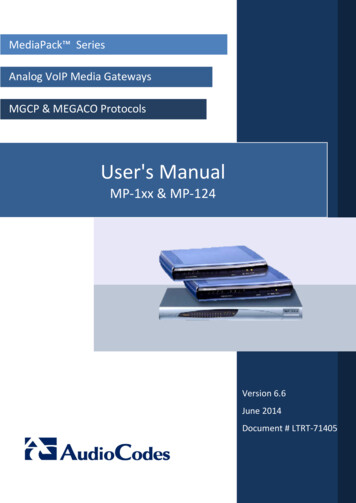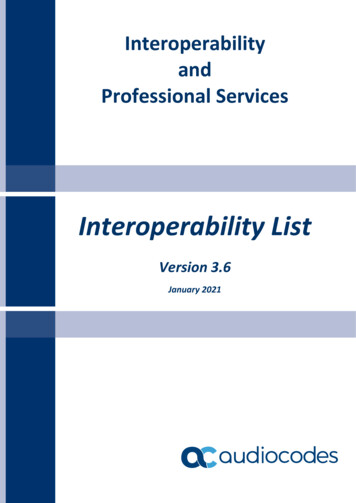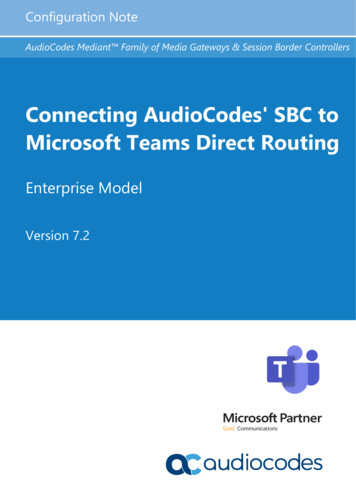
Transcription
Configuration NoteAudioCodes Mediant Family of Media Gateways & Session Border ControllersConnecting AudioCodes' SBC toMicrosoft Teams Direct RoutingEnterprise ModelVersion 7.2
Configuration NoteContentsTable of Contents1Introduction . 91.11.21.32About Microsoft Teams Direct Routing .9About AudioCodes SBC Product Series .9Validated AudioCodes Version .10Topology Example . 112.1.12.1.22.1.33Configuring Teams Direct Routing . 153.13.23.34Enterprise Model Implementation .11Environment Setup .12Infrastructure Prerequisites.13Prerequisites .15SBC Domain Name in the Teams Enterprise Model . 15Example of the Enterprise Office 365 Tenant Direct Routing Configuration . 173.3.13.3.23.3.33.3.43.3.53.3.6Add New SBC to Direct Routing .18Add Voice Route and PSTN Usage .19Add Voice Routing Policy .21Enable Online User .22Assigning Online User to the Voice Routing Policy .22Configure with User Management Pack 365 (Optional) .23Configuring AudioCodes' SBC . 254.14.2SBC Configuration Concept in Teams Direct Routing . 25IP Network Interfaces Configuration . 264.3SIP TLS Connection Configuration . 294.44.54.6Configure Media Realm .36Configure SIP Signaling Interfaces . 37Configure Proxy Sets and Proxy Address . 384.74.84.94.104.114.124.134.144.15Configure Coder Groups .41Configure IP Profiles.42Configure IP Groups .44Configure SRTP .46Configure Message Manipulation Rules . 47Configure Message Condition Rules . 48Configure Classification Rules . 49Configure IP-to-IP Call Routing Rules . 50Configure Firewall Settings (Optional) . 514.2.14.2.2Configure VLANs .27Configure Network Interfaces .274.3.14.3.24.3.34.3.44.3.54.3.6Configure the NTP Server Address .29Create a TLS Context for Teams Direct Routing .30Generate a CSR and Obtain the Certificate from a Supported CA .31Deploy the SBC and Root / Intermediate Certificates on the SBC .33Method of Generating and Installing the Wildcard Certificate .35Deploy Baltimore Trusted Root Certificate .354.6.14.6.2Configure Proxy Sets .38Configure Proxy Addresses .39Teams Direct Routing3AudioCodes SBC
Company5Verify the Pairing Between the SBC and Direct Routing . 536Make a Test Call . 55ASyntax Requirements for SIP Messages 'INVITE' and 'OPTIONS' . 57A.1A.2A.3A.4BTerminology.57Syntax Requirements for 'INVITE' Messages . 57Requirements for 'OPTIONS' Messages Syntax . 58Connectivity Interface Characteristics . 59SIP Proxy Direct Routing Requirements . 61B.1Failover Mechanism .61Configuration Note4Document #: LTRT-13325
Configuration NoteContentsList of FiguresFigure 2-1: Connection Topology with SIP Trunk on the LAN .11Figure 3-1: Example of Registered DNS Names.16Figure 3-2: Teams Admin Center .17Figure 3-3: Add new SBC to Direct Routing .18Figure 3-4: Configure new SBC .18Figure 3-5: Add New Voice Route .19Figure 3-6: Associate SBC with new Voice Route .20Figure 3-7: Associate PSTN Usage with New Voice Route .20Figure 3-8: Add New Voice Routing Policy .21Figure 3-9: Associate PSTN Usage with New Voice Routing Policy .22Figure 3-10: Example of Adding new Voice Route .23Figure 3-11: Example of Voice Routes Table.23Figure 4-1: SBC Configuration Concept .25Figure 4-2: Network Interfaces in the Topology with SIP Trunk on the LAN .26Figure 4-3: Network Interfaces in the Topology with SIP Trunk on the WAN .26Figure 4-4: Configured VLAN IDs in Ethernet Device .27Figure 4-5: Configuration Example of the Network Interface Table .28Figure 4-6: Configuring NTP Server Address.29Figure 4-7: Configuration of TLS Context for Direct Routing .30Figure 4-8: Configured TLS Context for Direct Routing and Interface to Manage the Certificates .31Figure 4-9: Example of Certificate Signing Request – Creating CSR .32Figure 4-10: Uploading the Certificate Obtained from the Certification Authority .33Figure 4-11: Message Indicating Successful Upload of the Certificate .33Figure 4-12: Certificate Information Example .34Figure 4-13: Example of Configured Trusted Root Certificates .34Figure 4-14: Configuration Example Media Realms in Media Realm Table .36Figure 4-15: Configuration Example of SIP Signaling Interfaces .38Figure 4-16: Configuration Example Proxy Sets in Proxy Sets Table .39Figure 4-17: Configuring Proxy Address for SIP Trunk .39Figure 4-18: Configuring Proxy Address for Teams Direct Routing Interface .40Figure 4-19: Configuring Coder Group for Teams Direct Routing.41Figure 4-20: Configured IP Groups in IP Group Table .46Figure 4-21: Configuring Media Security Parameter .46Figure 4-22: Configuring Condition Table .48Figure 4-23: Configuring Classification Rule .49Figure 4-24: Configured IP-to-IP Routing Rules in IP-to-IP Routing Table .50Figure 5-1: Proxy Set Status .53Figure A-1: Example of an 'INVITE' Message .57Figure A-2: Example of 'OPTIONS' message .58Teams Direct Routing5AudioCodes SBC
CompanyList of TablesTable 2-1: Environment Setup .12Table 2-2: Infrastructure Prerequisites .13Table 3-1: DNS Names Registered by an Administrator for an Enterprise Office 365 Tenant .15Table 4-1: Configuration Example of the Network Interface Table .27Table 4-2: New TLS Context .30Table 4-3: Configuration Example Media Realms in Media Realm Table .36Table 4-4: Configuration Example of SIP Signaling Interfaces .37Table 4-5: Configuration Example Proxy Sets in Proxy Sets Table .38Table 4-6: Configuration Proxy Address for SIP Trunk .39Table 4-7: Configuration Proxy Address for Teams Direct Routing .40Table 4-8: Configuration Example: Teams IP Profile .42Table 4-9: Configuration Example: SIP Trunk IP Profile .43Table 4-10: IP-to-IP Call Routing Rules .50Table 4-11: Firewall Table Rules .51Table A-1: Syntax Requirements for an 'OPTIONS' Message .58Table A-2: Teams Direct Routing Interface - Technical Characteristics .59Configuration Note6Document #: LTRT-13325
Configuration NoteNoticesNoticeInformation contained in this document is believed to be accurate and reliable at the time ofprinting. However, due to ongoing product improvements and revisions, AudioCodes cannotguarantee accuracy of printed material after the Date Published nor can it accept responsibilityfor errors or omissions. Updates to this document can be downloaded ocuments.This document is subject to change without notice.Date Published: May-06-2021WEEE EU DirectivePursuant to the WEEE EU Directive, electronic and electrical waste must not be disposed ofwith unsorted waste. Please contact your local recycling authority for disposal of this product.Customer SupportCustomer technical support and services are provided by AudioCodes or by an authorizedAudioCodes Service Partner. For more information on how to buy technical support forAudioCodes products and for contact information, please visit our website tenance-and-support.Stay in the Loop with AudioCodesAbbreviations and TerminologyEach abbreviation, unless widely used, is spelled out in full when first used.Related DocumentationDocument NameMediant 500 Gateway & E-SBC User's ManualMediant 500L Gateway & E-SBC User's ManualMediant 800 Gateway & E-SBC User's ManualMediant 1000B Gateway & E-SBC User's ManualMediant 2600 SBC User's ManualMediant 4000 SBC User's ManualMediant 9000 SBC User's ManualMediant Software SBC User's ManualGateway and SBC CLI Reference GuideTeams Direct Routing7AudioCodes SBC
CompanyDocument NameSIP Message Manipulation Reference GuideAudioCodes Configuration NotesDocument Revision RecordLTRTDescriptionLTRT-TAPAdded Chapter “Direct Routing Media Optimization” for Direct Routing MediaOptimization Routing between Microsoft Phone System (Cloud PBX) and SBCdevices.LTRT-TAPUpdates in Section “Configuring SBC for Media Optimization Proxy SBC”; Site SBCsRe-configuration.13320Updates to IP Profile configuration in Chapter “Configuring SBC for MediaOptimization Proxy SBC” and Chapter “Site SBCs Re-configuration”13320Updates to Table "Configuration Example: Teams IP Profile” (updated parametersRemote REFER Mode and Remote 3xx Mode), Added Table “Configuration Example:SIP Trunk IP Profile (toward Remote SBC)”, Changed title for Table “ConfigurationExample: Teams IP Profile (through the Proxy SBC) and Table “ConfigurationExample: SIP Trunk IP Profile (toward SIP Provider/ Media Gateway)”.13321Updates to the names of the IP Group Media optimization parameters to “Local MediaOptimization and “Teams Local Media Optimization Initial Behavior”, Added Appendix“IP Profile – Quick Guidelines”13322Added Sections “Adopt Gateway Application to Work with Local Media Optimization”and Appendix C “Local Media Optimization – Quick Guidelines”13323Update to the “Related Documentation” table to include the Mediant 1000B Gateway& E-SBC product.13324All information related to Local Media Optimization was removed to a separatedocument. “Connecting AudioCodes' SBC to Microsoft Teams Direct Routing LocalMedia Optimization”13325Update for Message Manipulation rule towards Microsoft TeamsDocumentation FeedbackAudioCodes continually strives to produce high quality documentation. If you have anycomments (suggestions or errors) regarding this document, please fill out the DocumentationFeedback form on our website at ck.Configuration Note8Document #: LTRT-13325
Configuration Note11. IntroductionIntroductionThis document describes how to connect AudioCodes' SBC to Teams Direct RoutingEnterprise model and refers to the AudioCodes SBC configuration only. For configuring theOffice 365 side, please refer to rectrouting-configure.This document is intended for IT or telephony professionals.Note: To zoom in on screenshots of example Web interface configurations,press Ctrl and .1.1About Microsoft Teams Direct RoutingTeams Direct Routing allows connecting a customer-provided SBC to Microsoft PhoneSystem. The customer-provided SBC can be connected to almost any telephony trunk orconnect with third-party PSTN equipment. The connection allows:1.2 Using virtually any PSTN trunk with Microsoft Phone System Configuring interoperability between customer-owned telephony equipment, such asthird-party PBXs, analog devices, and Microsoft Phone SystemAbout AudioCodes SBC Product SeriesAudioCodes' family of SBC devices enables reliable connectivity and security between theenterprise's VoIP network and the service provider's VoIP network.The SBC provides perimeter defense as a way of protecting enterprises from malicious VoIPattacks; mediation for allowing the connection of any PBX and/or IP-PBX to any serviceprovider; and Service Assurance for service quality and manageability.Designed as a cost-effective appliance, the SBC is based on field-proven VoIP and networkservices with a native host processor, allowing the creation of purpose-built multiserviceappliances, providing smooth connectivity to cloud services, with integrated quality of service,SLA monitoring, security and manageability. The native implementation of SBC provides ahost of additional capabilities that are not possible with standalone SBC appliances such asVoIP mediation, PSTN access survivability, and third-party value-added servicesapplications. This enables enterprises to utilize the advantages of converged networks andeliminate the need for standalone appliances.AudioCodes' SBC is available as an integrated solution running on top of its field-provenMediant Media Gateway and Multi-Service Business Router platforms, or as a software-onlysolution for deployment with third-party hardware. The SBC can be offered as a VirtualizedSBC, supporting the following platforms: Hyper-V, AWS, AZURE, AWP, KVM and VMWare.Teams Direct Routing9AudioCodes SBC
Company1.3Validated AudioCodes VersionMicrosoft has successfully conducted validation tests with AudioCodes' Mediant SBCVer. 7.20A.258. Previous firmware versions may run successfully; however, Microsoft did nottest such versions. For an updated list, refer to List of Session Border Controllers certified forDirect Routing.Note: For implementing Microsoft Teams Direct Routing based on the configurationdescribed in this document, AudioCodes SBC must be installed with a License Key thatincludes the following features: MSFT (general Microsoft license)Note: By default, all AudioCodes media gateways and SBCs are shipped with thislicense (except MSBR products, Mediant 500 SBC, and Mediant 500 MediaGateway). SW/TEAMS (Microsoft Teams lic
May 06, 2021 · The customer-provided SBC can be connected to almost any telephony trunk or connect with third-party PSTN equipment. The connection allows: . appliances, providing smooth connectivity to cloud services, with integrated quality of service, SLA monitoring, security and m
